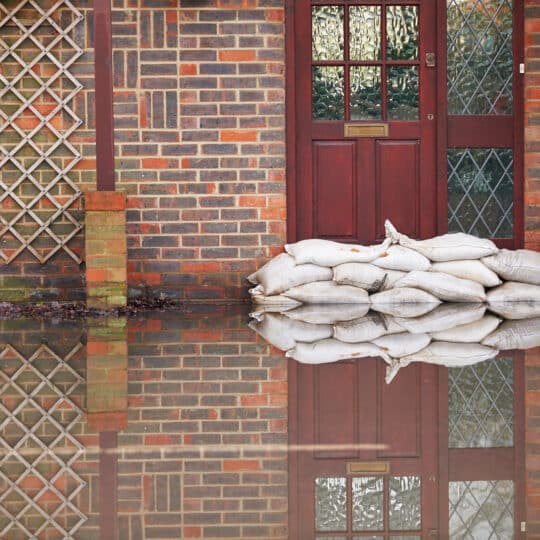Cleaning Out a Flooded Property
What to do Before, During & After

Cleaning up after a flood can take a physical and emotional toll. Not only is there work to do to immediately salvage a home or business, but there are also health and safety concerns to consider for the future. Approach the process systematically to make the task more manageable. Follow these tips for cleaning out a flooded property, and don’t be afraid to ask for help.
Before Flood Cleanout Begins
Whether you’re currently occupying the damaged property or have returned to discover damage, there are certain steps to take before cleaning out a flooded property.
- Safety first. Once the flood waters recede, ensure the structure is sound before entering. Flooding compromises flooring, walls, and stairs. Make sure the electricity and gas are shut off to avoid leaks and electrocution. Wear rubber boots, gloves, and masks to help protect yourself from mold and other contaminants.
- Document the damage. Before anything is removed, take pictures of the damage to use for insurance claims. List any possessions that will need to be repaired or discarded.
- Ventilate the area. Open windows and doors to increase air circulation and help reduce moisture buildup. If possible, use fans, dehumidifiers, and heaters to help dry everything out.
Even though it may seem like a monumental task to clean up and dry out, safety should be the prime concern. Once you’ve determined the area is safe, it’s time to start cleaning.
Cleaning Out a Flooded Property
After items have been assessed and documented you can start salvaging and discarding. Keep in mind, the longer items stay wet, the more likely you’ll have to deal with mold and bacteria later. Here’s how to go about deciding what stays and goes.
- Remove standing water. Use a wet/dry vacuum, mop, and towels to remove as much water as possible. Use caution when emptying a vac or bucket as drains may also be backed up.
- Salvageable hard surfaces. Metal, glass, and plastic items can be cleaned and sanitized.
- Removable water-damage. Any drywall, insulation, wood flooring, and other porous material that has been soaked for over 24 hours is more susceptible to mold growth.
- Discard contaminated materials. Soaked carpets, mattresses, and upholstery are harder to dry out and could harbor mold and bacteria.
It may be safer to toss whatever is water-damaged than wait for them to dry and sanitize. Of course, there are budget concerns. When trying to decide whether to remove or repair an item, consider the cost to buy something new or clean the area and treat mold.
Preventing Mold Growth
After the area has been cleaned out, there’s still the question of what the future holds. It only takes 24 to 48 hours for mold and bacteria to grow in moist conditions. Even if you’ve removed wet materials, it’s still a good idea to treat the remaining area to prevent mold.
- Clean affected areas with bleach or other disinfectants designed to kill mold.
- Target floors and walls first then disinfect all surfaces to kill bacteria and mold.
- Anything that’s been in contact with contaminated water should be treated as hazardous.
- Regularly inspect for mold and address immediately. Look for black spots or fuzzy patches on surfaces.
- If mold covers more than 10 square feet or if it’s black mold, call a professional remediation team.
Keep an eye out for mold as you’re repairing the structure, from the foundation to the attic. You may even want to hire a professional to inspect the area to make sure you didn’t miss anything.
Preparing for the Future
No one wants to deal with a flood. But if you live in an area that’s known for flooding, you may not be able to get insurance for it. It’s best to prepare for the worst, no matter where you live and work.
- Consider installing a sump pump or an improved drainage system to prevent future flooding.
- When choosing flooring, think about the risk of flooding in the area and pick something water-resistant like tile or laminate.
- When possible, elevate storage spaces, appliances, and electrical systems to reduce damage.
- Ensure any cracks in the foundation, basement, and throughout the house are sealed to prevent water from entering.
- Storing items in clear plastic containers not only makes it easier to organize, but it also helps prevent water damage.
Planning may not prevent a flood from happening, but it can certainly make it easier to clean up afterward and less likely you’ll have to deal with long-term problems like mold or structural damage.
Let JDog Junk Removal & Hauling Help Clean Out Your Flooded Property
After any natural disaster, you tend to see the community come together to help each other out. JDog is proud to serve our community every day and especially when there’s a greater need. You don’t have to cleanout your flooded home or business alone. JDog Junk Removal & Hauling offers a number of services to help get your space back to normal. From removing water-logged carpet and furniture to cleaning out an entire basement, our dedicated team of Veterans and Military family members live and work by the ethos we learned during our time serving our country. We’re part of this community too, and you can trust we’ll respect your time, space, and belongings while disposing of them responsibly.